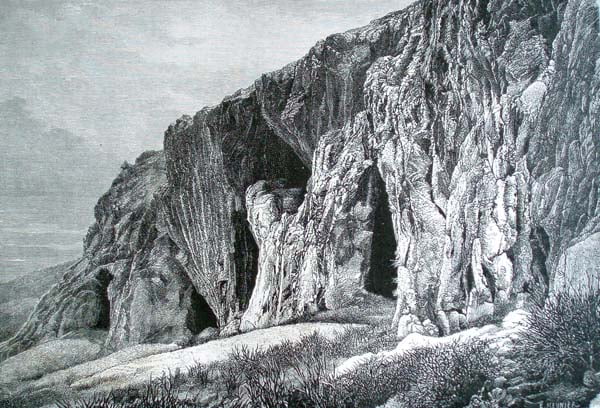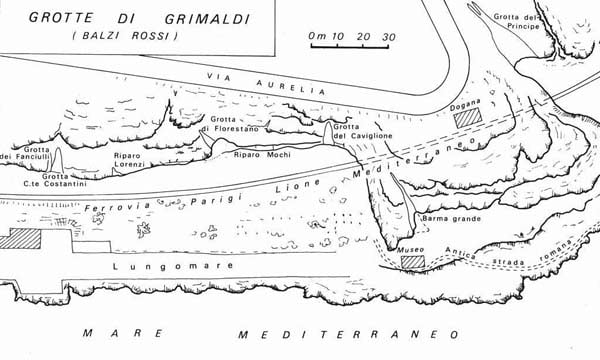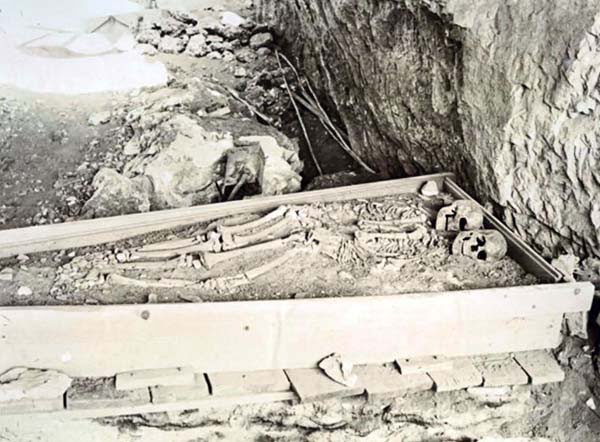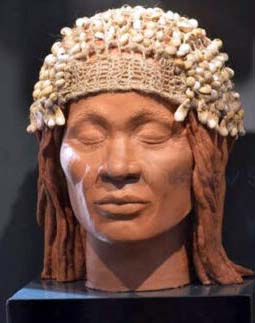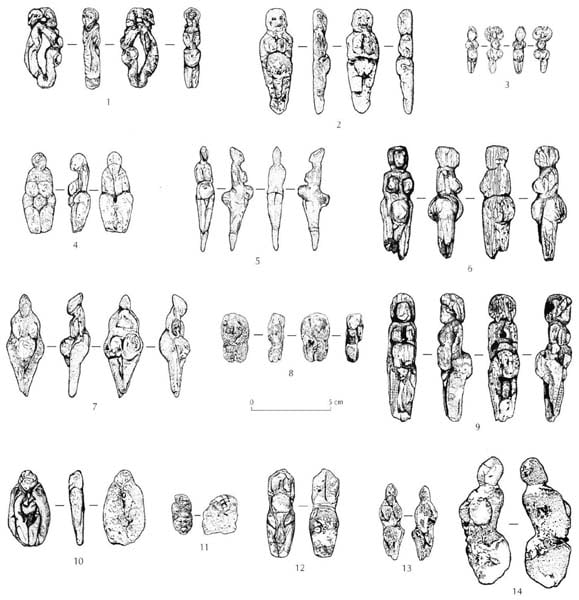di Antonella Traverso
The searches
The Balzi Rossi caves, originally 11 in number, were already known in 1700, but the first to conduct scientific investigations there was Prince Florestano I of Monaco in 1846. However, the first to describe the complex stratigraphy of some of the caves of the Balzi Rossi was François Forel, president of the Historical Society of French-speaking Switzerland who carried out excavations in the Caviglione and Barma Grande caves in 1858.
The Caviglione cave in particular is linked to the French doctor Emile Rivière, during a therapeutic stay on the Côte d'Azur at the end of the 800th century; this, with the help of Stanislas Bonfils, who had already carried out preliminary excavation tests in the years 1864-1865, began the research in October 1870, following the works for the construction of the Genoa - Nice railway line. Systematic investigations soon concentrated on the Grotta del Caviglione, where more than 7 meters of archaeological deposits were crossed.
On March 26, 1872 at 6,55 meters below the surface level of the cave and about 25 meters above sea level, the burial of an adult individual was brought to light who for a long time – until 2016 – will be known as the Man of Menton. In April of the same year, after 20 days of work, the burial was removed en bloc with the surrounding deposit and was transferred to Paris where it has been exhibited since 1937 at the Musée de l'Homme.

In 1883 the area of the Barma Grande and the Barma du Bausu da Ture were bought by a small local businessman, Francesco Abbo, who first built a sales outlet at the entrance to the caves for visitors and later opened a quarry for the exploitation of limestone.
The first searches initiated by Prince Albert I of Monaco, opposed by the Abbo family and by Rivière himself (who believed he was the owner of the lands and caves), were continued by local enthusiasts: Stanislas Bonfils and Louis Alexandre Jullien, art dealer and collector of Marseille origin.
It was the latter who discovered in the deposit of the Barma Grande a burial which became part of the Museum of Mentone and fifteen female stone statuettes, seven of which were sold by him in 1896, while the rest were taken to Canada, where Jullien had moved and from where he will return to resume his research in the following years.
In 1892 the work of the Abbo family brought to light the triple burial about 11 meters from the original level of the Barma Grande.
The Dame du Cavillon (Woman of Caviglione, formerly known as Man of Menton) and the archaeological research at the Balzi Rossi caves
The complex archaeological stratigraphies that have been brought to light in over two hundred years of research in the numerous caves and shelters testify to the human presence starting from the Lower Paleolithic (230.000 years ago) up to the Upper one (from 24.000 to 11.000 years ago).
In particular, it is from this period that the caves were used as a burial ground; during the research of the last two centuries, 16 individuals were recovered, deposited singly or in multiple graves. Of these burials, 13 date to a period between 25.000 and 23.000 years ago while three, later, date to a period between 12.300 and 11.000 years ago.
The historical events linked to this border site have meant that many of these skeletons are distributed in numerous European museums.
At the Balzi Rossi Museum, the cast of the so-called burial of the is currently visible Dame du Cavillon – previously attributed by the discoverer Emile Rivière to a man of robust size – which recent studies coordinated by the French archaeologist Henry De Lumley and concluded in 2016 have shown to be a woman of about 37 years, who had given birth at least once, and whose face is reconstructed in the museum. The remains of a cap (or headdress) made of shells and deer teeth were found on the head of the buried woman. Her body was covered in red ochre, she lay on her left side and facing west, with her hands close to her face and her legs folded. In the burial there was also a set of bones of an equid, an ancestor of the horse, now extinct.
The female figurines
The figurines made with various raw materials (stone, bone, ivory) are characteristic of the Upper Paleolithic, in particular of the so-called Gravettian phases. Those found in the Balzi Rossi caves are around 10 cm in size and have the usual exasperated female characteristics: large breasts, pronounced buttocks and an evident belly. The head on the contrary is just mentioned and sometimes absent.
The discovery of the 15 Paleolithic Venuses of the Balzi Rossi is linked to the figure of Louis Alexandre Jullien, a Marseilles antiquarian active in the caves since 1883, who was repeatedly authorized by the Abbo family to recover the prehistoric materials from the caves. He probably he found the statuettes in the caves of Barma Grande and Principe where the quarry works were more active.
Between 1896 and 1903, 7 of these figurines found by Jullien were purchased by the Museum of Antiquitées Nationales de St. Germain en Laye in France, where they are still kept. The remaining figurines Jullien had mentioned in his correspondence were lost until 1944, when an eighth figurine was sold by a daughter of Jullien's to Peabody Museum of Harvard. In 1986, Jullien's granddaughters gave way to others 5 figurines to a Canadian antique dealer who resold them to a Montreal sculptor.
Copies of the 7 statuettes kept in France are exhibited at the Balzi Rossi Museum.
01 – The double figurine, or “Beauty and the Beast”
02 – The figurine with the pierced neck, or “Janus”
03 – The Two-headed
04 - The yellow steatite figurine, or Venus of Menton
05 – Pulcinella or the Venus of Policinella
06 – Brown ivory figurine
07 – The Venus in Rhombus, or Venus Lozenge
08 – The Bust
09 – The ocher Lady
10 – The Nun
11 – The Negroid head
12 – The Hermaphrodite
13 – The Woman with the Goiter
14 – The Unnamed
The Mask (the fifteenth figurine) was not depicted in the White and Bisson plate
Antonella Traverso – Director of the Balzi Rossi Prehistoric Museum – Ventimiglia - March 2021
REFERENCES
- Vincenzo Formicola and Brigitte M. Holt – “Tall guys and fat ladies: Grimaldi/s Upper Paleolithic burials and figurines in a historical perspective” – in Journal of Anthropological Sciences – Vol 93 – 2015;
- Randall White and Michael Bisson – “Imagerie féminine du Paleolithique: l'apport des nouvelles statuettes de Grimaldi” – in Prehistory Gaul – volume 40, 1998;
- Luciano Malpieri and Anna Orlandini – The splintered vulcanites of the “Barma Grande” at Balzi Rossi di Grimaldi – Conference at the Meeting of the Italian Mineralogical Society of 11 October 1968 in Naples;
- Tony Chevalier, Gaspard Guipert, Henri Stalens, Jean Luc Voisin and Dominique Clere – “A new anatomical study of the skeleton of “la Dame du Cavillon” - In The Cave of Cavillon – Paris 2016.

